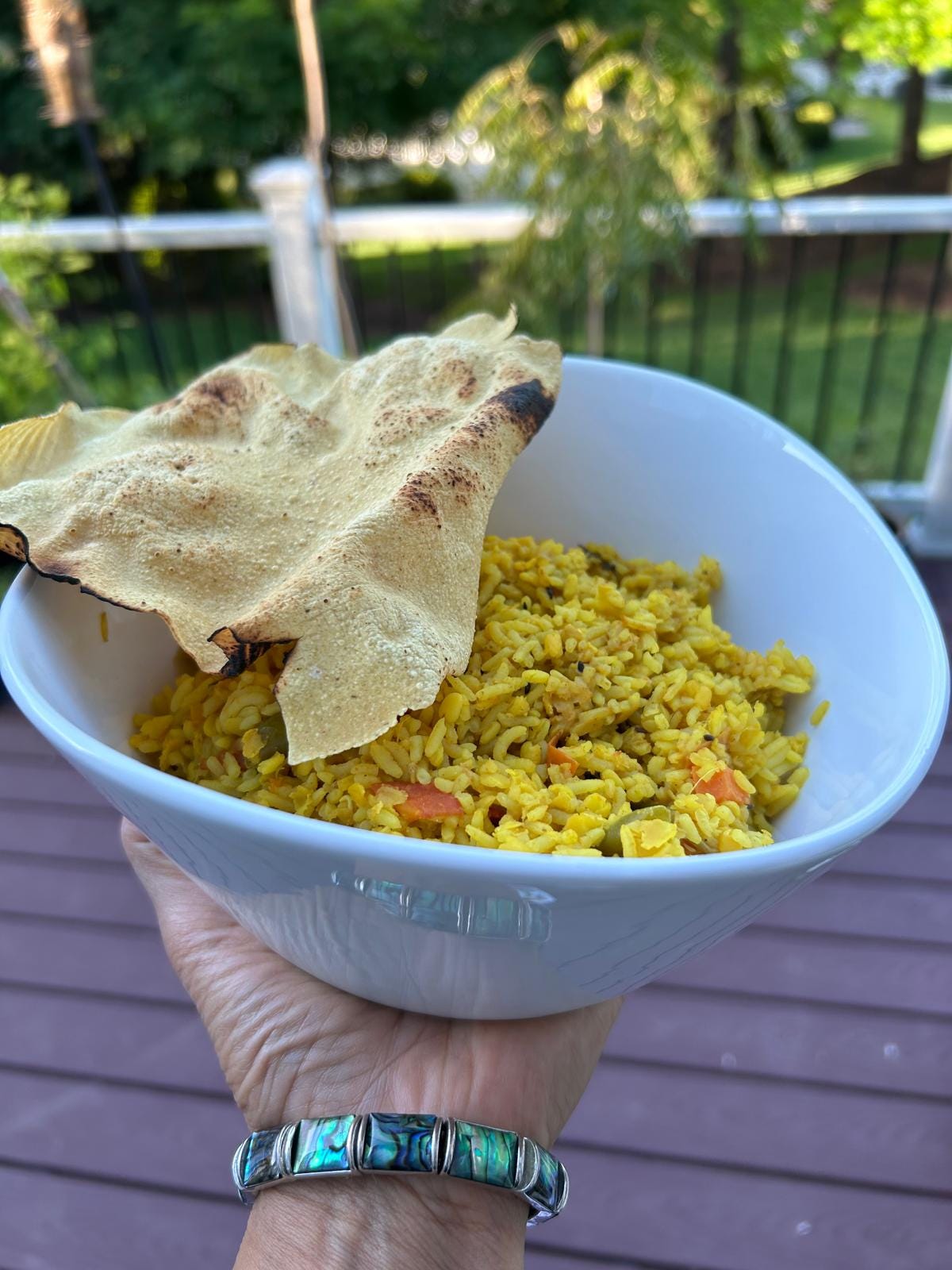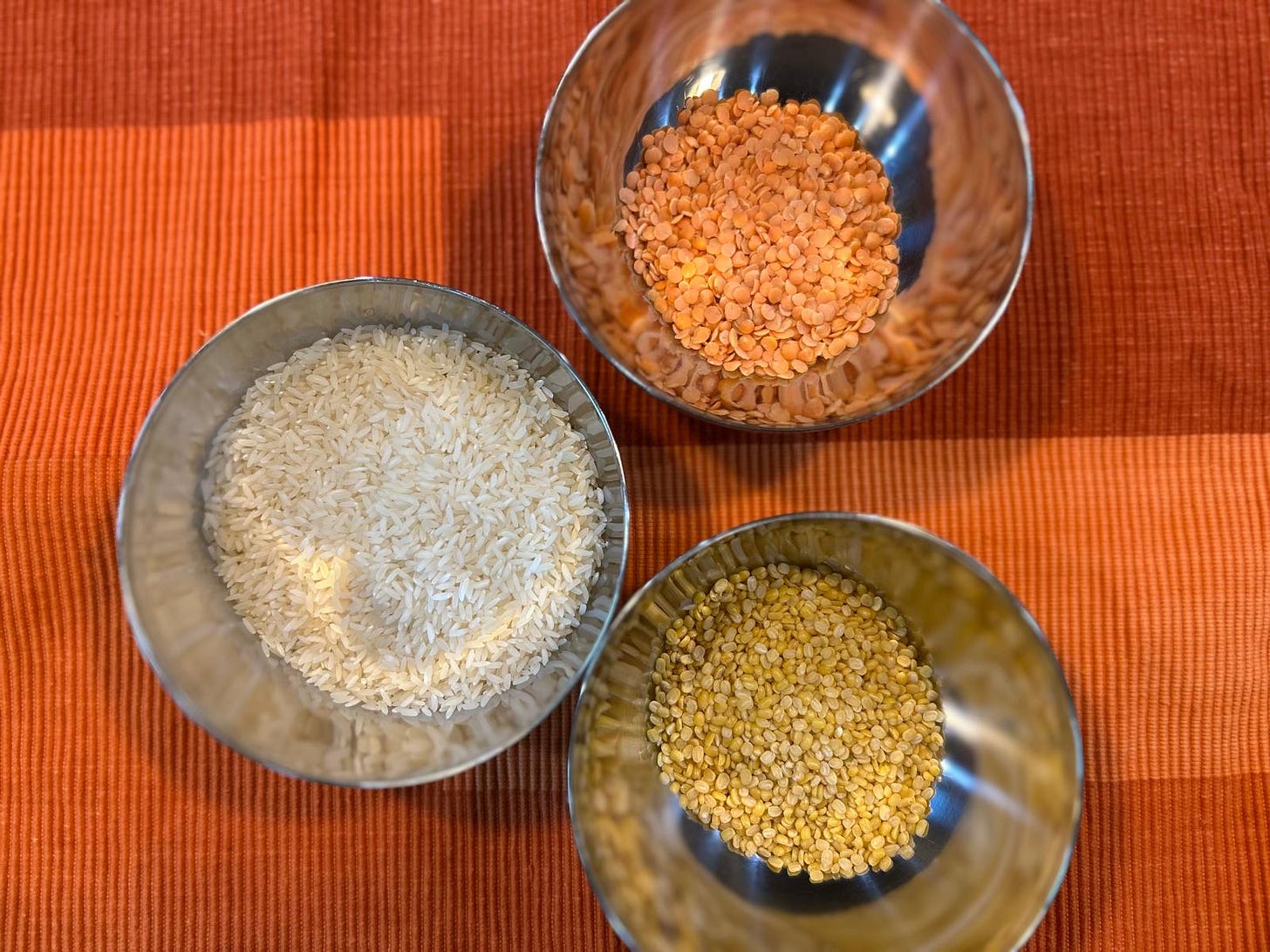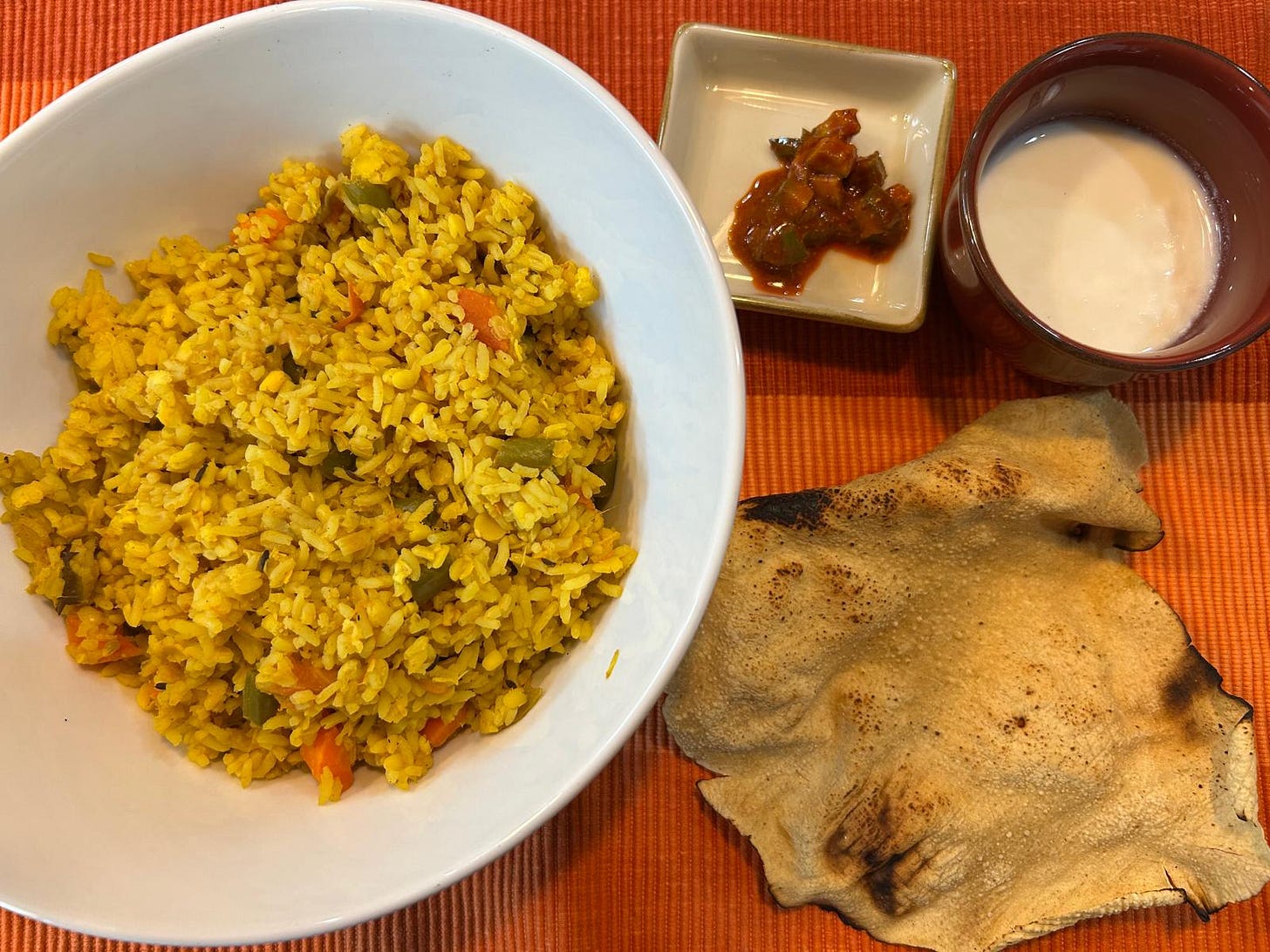There are days when we want to believe that everyone and everything in our life exists for the sole purpose of inflicting misery. Cook Khichdi on those days! Served with plain yogurt, achaar (Indian pickle) and/or paapad, Khichdi fills, satiates, warms, comforts, gratifies the taste buds, gets you off the victim high horse and results in bliss that all is well in the world.
Prepared throughout the country except in the southern state of Kerala, every household has its own khichdi. It is an anytime meal ideally suited for harried, crazed days when homemade food is non-negotiable. Here is how Khichdi enjoys a premier position in Indian kitchens –
The word Khichdi means an unplanned mixture, in short, a hot mess. When someone generates a weird combo of clothes or music, it is lampooned as Khichdi. The meal is far from it, I promise.
Paired to the basics, Khichdi is a one pot meal of rice and yellow split mung dal with salt and turmeric powder as the only seasoning.
In most Indian homes, Khichdi is a baby’s first solid food.
Khichdi is the prescribed meal for sick tummies, picky eaters and recovering patients and usually the first meal of choice at home after a long travel.
There are a gazillion Khichdi varieties a) with or without spices and vegetables, b) with a choice of lentils – yellow, split mung dal or split husked mung dal or red lentils c) with textural differences – some prefer the mushy, porridge-y, oatmeal-like texture and some like my mother want the every-grain-distinct texture.
According to Ayurveda, the ancient Indian science of holistic medicine, Khichdi is a perfect meal because it suits all constitutions
Ayurveda also espouses Khichdi for hot weather or when one is feeling under the weather as it is easy to digest
Khichdi has been hijacked and touted by the wellness movement as a superfood. Mangled, and mispronounced to kitchari, khichri, the whole bit makes me queasy! For eons, the humble Khichdi has been feeding people without any expectations and its worth is so damn obvious that it does not need any newly found publicity from recent adopters. Beware of online recipes that pair Khichdi with chutneys. You know me, I’m the first person to plug a chutney but no, not with Khichdi.
My preference is a Masala Khichdi, a one-pot meal that pairs beautifully with no-cooking-required sides of plain yogurt, paapad and/or pickles.
RECiPE – MaSALa KHiCHDi
Ingredients
3/4 cup short or medium grain rice (I use sona masuri, available in Asian grocery stores)
1/4 cup yellow split mung dal
1 handful red lentils
2 tablespoons ghee or any neutral oil (if vegan)
1/4 teaspoon cumin seeds
10-15 curry leaves
7-8 black peppercorns
1” cinnamon stick
½ teaspoon turmeric powder
1 medium red onion or 3/4 cup peeled, diced into 0.5”x0.25” pieces
1 medium tomato chopped into ½” x ½” pieces
1 tablespoon ginger peeled and grated or thinly sliced
1 cup cut carrots and beans (carrots into 1/4” thick half-moon shape pieces and beans into 1/2” long pieces)
1 teaspoon coriander powder
1/2 teaspoon garam masala
1/2 teaspoon red chile powder
3/4 teaspoon salt
2 teaspoons tomato ketchup
Yield – Serves 2/3 people
Method
Combine ¾ cup rice, ¼ cup split yellow mung dal and handful red lentils and wash them thoroughly till the drained water runs clear. I had to rinse them 4 times for the water to turn clear. Set aside to soak for 30 minutes till the water covers the rice and dal mixture, if you have the time. If not soak for at least 15 minutes.
Heat 2 tablespoons ghee or neutral oil in thick-bottomed pot at medium heat.
After letting the ghee heat up for 2 minutes, add 1/4 teaspoon cumin seeds and once they stop sizzling, follow up with 10-15 curry leaves, 7-8 black peppercorns, 1” cinnamon stick, ½ cup onion pieces and 1/2 teaspoon turmeric powder. The aroma of onions, cumin, peppercorns and cinnamon is heady.
Sauté for 7-8 minutes till the onions acquire a brown edge. Combine in the diced pieces of 1 tomato, a cup of diced carrots and green beans, 1 tablespoon grated ginger and ¾ tsp salt. Let the vegetables sweat and cook for 5 minutes. Mix 1 teaspoon coriander powder, ½ teaspoon garam masala, ½ teaspoon red chile powder and 2 teaspoons ketchup with the vegetables.
Drain the water from the rice and dal mixture and add it to the Khichdi pot and stir well.
Pour 4 cups water and raise the heat to high.
The mixture will start boiling in about 10 minutes. Keep an eye on it. Be on the lookout for when the liquid disappears. This should take another 10 minutes.
Once the liquid is gone, lower the heat to medium and cover with a lid.
After 5 minutes, check a grain of rice between the thumb and index finger of your dominant hand. If the grain squishes easily, the Khichdi is ready. If the rice does not squish easily, perform the same test in another 2-3 minutes. Turn the heat off and let the khichdi rest for at least 10 minutes with the lid continuing to cover the pot.
Pour ghee generously on the Khichdi and eat warm with a pickle, a bowl of plain yogurt and roasted or deep-fried paapad.
TECHNiQUE – WATER/RICE RATIO
While cooking rice on the stovetop, the quantity of water in relation to the amount of rice is the most important decision to be made. What has served me well over my 20+ years of cooking rice is the 2:1 (water:rice) ratio. And I play with this ratio depending on if I am cooking jasmine rice (1.5:1) for an Asian meal with Vegetable Manchurian or a soupy Khichdi (4:1), that my mother-in-law prepares. It’s an absolutely necessary meal for me when I have a nasty cold and feel like cutting my nose off.
Every time I go to India, I hear conversation about how older the rice, the more water it needs with names of varieties of rice thrown in. Now this talk seems rather adult to me - definitely above my comprehension grade – conducted breezily between culinary wizards who take a passing whiff of the dal cooking on the stovetop and know it needs more salt.
For basmati rice, 2:1 is good for rice where distinct grains are wanted. That ratio is applicable when mixed with dal too. Pulao and biryani demand a taut but fully cooked grain though and a 1:1 or 1.25:1 is fine. For a short-medium grain rice like sona masuri, 2.5:1 works.
For the Masala Khichdi, we are going to do a 4:1 to let the vegetables cook and give the rice an oatmeal-ish texture. All these proportions take into account soaking for 20-30 minutes.
ChRONOLOGY OF STePS
Rinse and soak the rice and lentils
Cut the vegetables if using fresh ones
Peel and grate ginger
Start collecting all the rest of your ingredients
Start cooking Khichdi
GRoCERY LIST
(Please note that I get a small something if you buy the above products from these links)
ChutneyLovers’ next meal highlights potatoes - saucy ones and dry ones. We will discuss two potato sabjis and how they have become pantry meals for Indian cooks. They can become your go-to weekday meals too.








The best days and times come after consuming this kinda meal!! It feels like a reassuring hug :) what say?
TRY IT